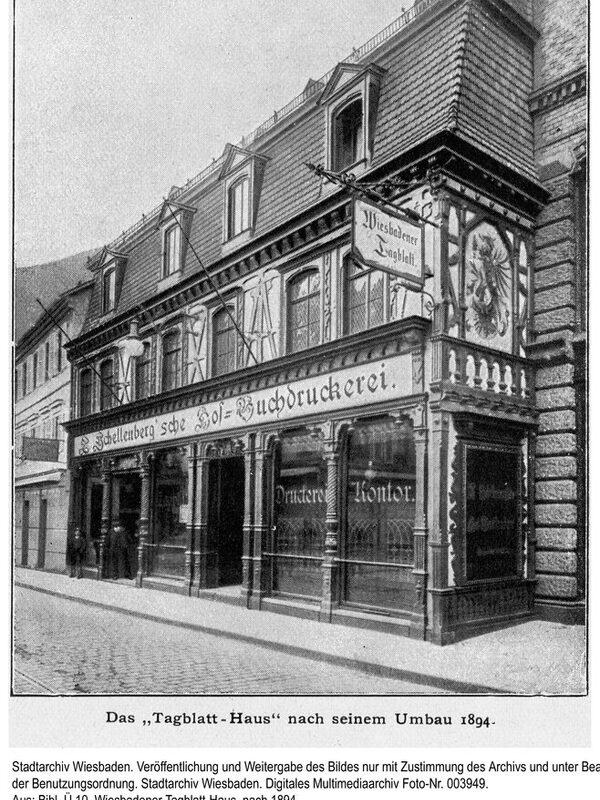Wiesbadener Tagblatt (WT)
Karl August Emil Schellenberg developed the Wiesbadener Tagblatt (WT) from the Wiesbadener Wochenblatt, which he first published on September 16, 1852 as a pure advertising paper, initially only in paperback format and with only a few pages. With official announcements and the popular serialized novels, the WT gained a large number of readers. His son Ferdinand Ludwig (Louis) Schellenberg turned the paper into a "proper" newspaper with an editorial section.
The brilliant rise to become Wiesbaden's most widely read daily newspaper began in 1889 with the appointment of Walther Schulte vom Brühl as editor-in-chief. From 1891, the WT, now in a larger format, was published every working day with a morning and an evening edition. In 1906, the WT was ranked eighth in a Germany-wide comparison of advertising volume at Christmas time, ahead of the "Frankfurter Generalanzeiger".
Politically, the WT tended towards the free-minded (liberal) party until the First World War. Profits were so high that the press building in Langgasse (today the headquarters of the local editorial offices of the WT and Wiesbadener Kurier, WK) could be built in the years 1905-09. After Schellenberg's death in 1920, his widow Marie, together with the capable authorized signatory Heinrich Pabst, managed the newspaper and printing plant through the difficult 1920s. In 1932, his son Gustav Schellenberg took over the company.
After the National Socialists came to power, the Jewish editor-in-chief Hermann Lekisch had to be dismissed (he was deported to the concentration camp in Lublin in 1942 and murdered in Sobibór in 1942). In terms of its political orientation, the WT moved more to the right and was initially able to continue publication. On June 30, 1943, it was merged with the NSDAP newspaper "Nassauer Volksblatt" to form the National Socialist "Wiesbadener Zeitung" due to "war-related necessities". After the invasion of American troops in April 1945, Gustav Schellenberg was banned from his home and profession. From October 1945, the Wiesbadener Kurier (WK), licensed by the American administration, used buildings and machinery on a leasehold basis.
When the ban was lifted, Gustav Schellenberg revived the WT in rented premises in Herrnmühlgasse. However, it soon became apparent that the WK's head start was too great. While retaining its traditional title, it joined the "Allgemeine Zeitung" published by the Mainzer Verlagsanstalt (now the Rhein Main publishing group). The local editorial team remained in Wiesbaden and, after an interlude on the Michelsberg, moved back to the newspaper building in Langgasse in April 1999.
Currently, WT and WK are published in identical versions apart from the title head. The circulation figures are also no longer shown separately.
Literature
Müller-Schellenberg, Guntram: Wiesbaden's press history, vol. 1: From Napoleon to Bismarck. The press in the field of tension between culture, economy and social conditions. Taunusstein 2011.
Always in the thick of it. 100 years of the Wiesbaden Press House. Edited by: Schröder, Stefan/Gerber, Manfred, Frankfurt 2009.
